Empowering Splitwise Users with Smarter Expense Management
Introduced admin roles, proxy payers, auto reminder, and multi-currency support to make expense management effortless and transparent.
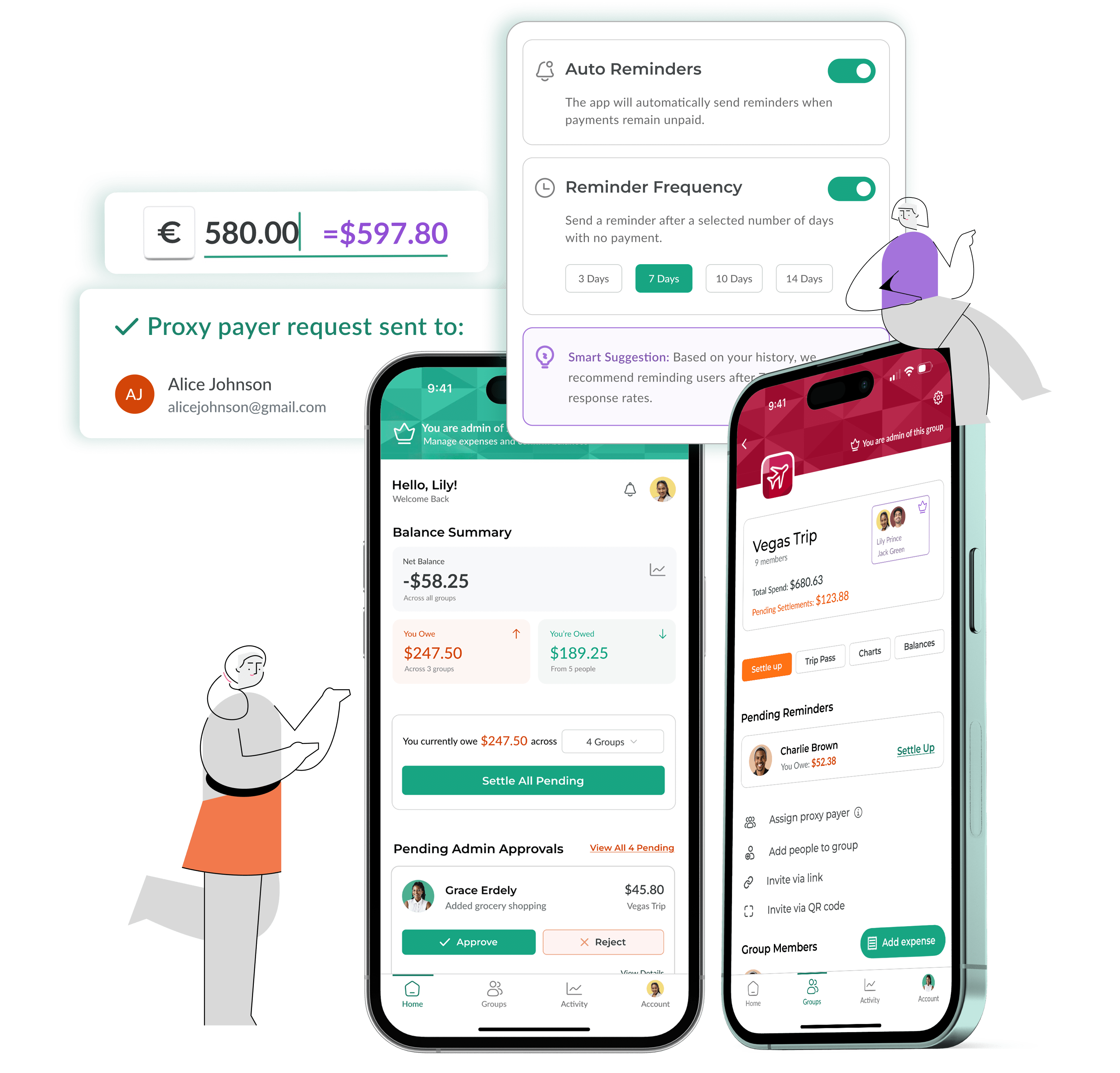
Introduction
Splitwise, a diamond built on trust!
Splitwise is a popular app for easily splitting expenses among friends and groups. At its core, it values friendship and fairness, making sure no one feels awkward about money, even its diamond-shaped design subtly reminds users that true friendships, like diamonds, are precious and worth keeping clear.
Can Splitwise really preserve the friendships it promises to protect? Let’s find out.

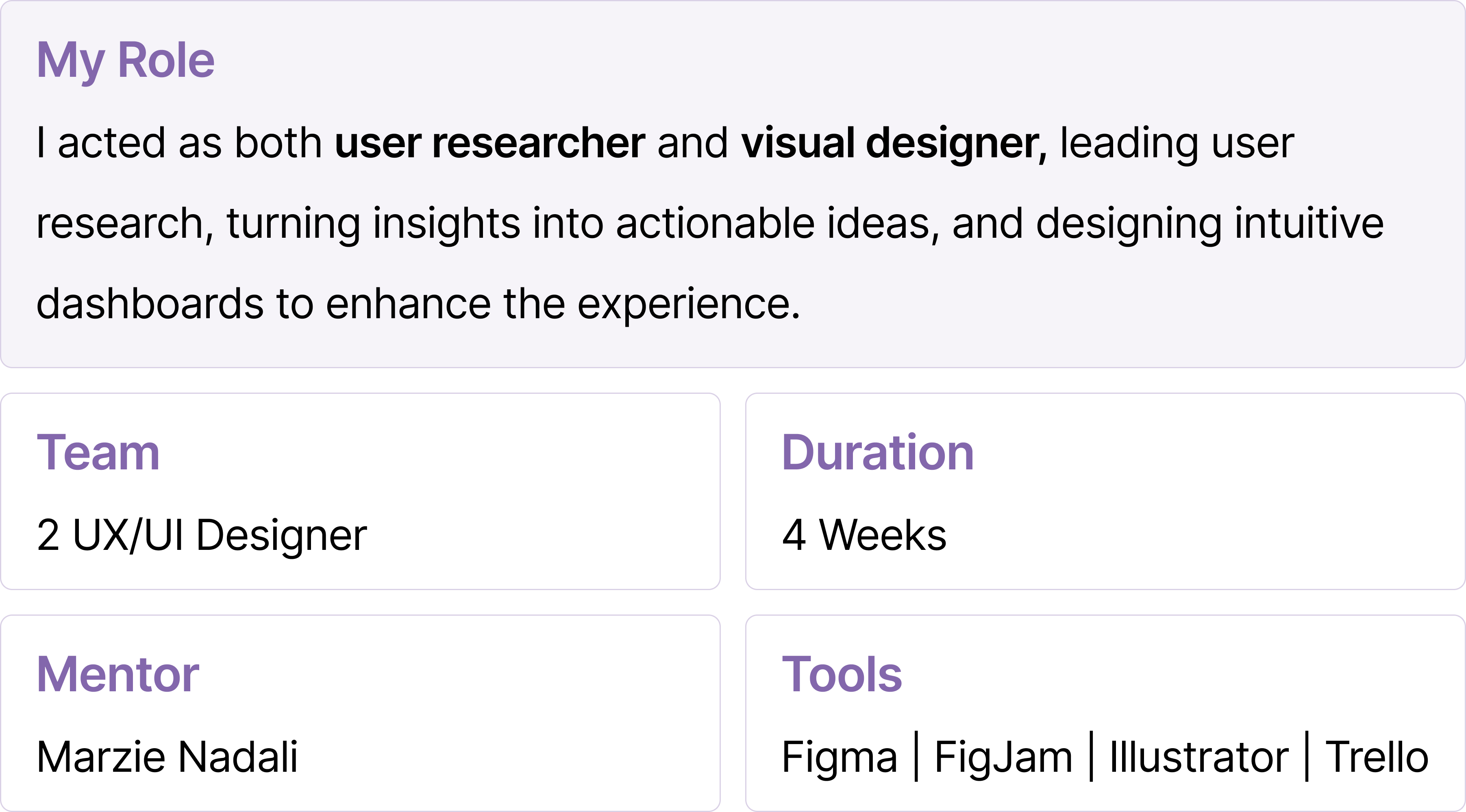
What is the problem?
Splitwise users face challenges in managing large groups, such as tracking individual contributions, splitting specific bills, or resolving disputes, impacting its usability for shared expenses.
As groups get larger, keeping track of who paid, what’s still pending, and managing disputes can get confusing. This project aims to simplify expense management and increase trust and transparency.
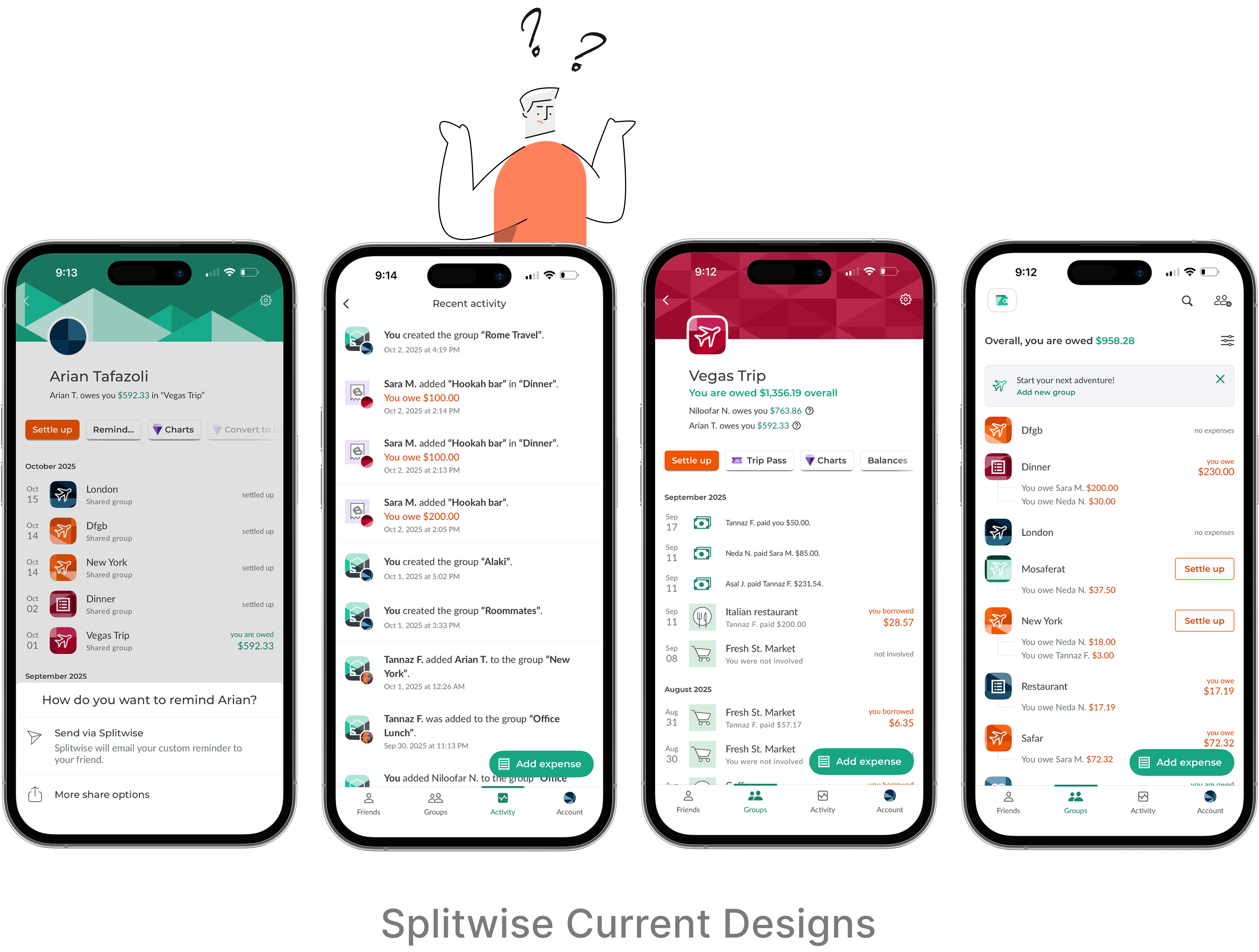
What are we aiming to achieve in our design?
To simplify group expense management by improving Splitwise’s flexibility and clarity, ensuring users can track, split, and settle expenses effortlessly, with less confusion and more confidence.
This project’s design goal is to make Splitwise a tool that supports both fairness and friendship through clarity.
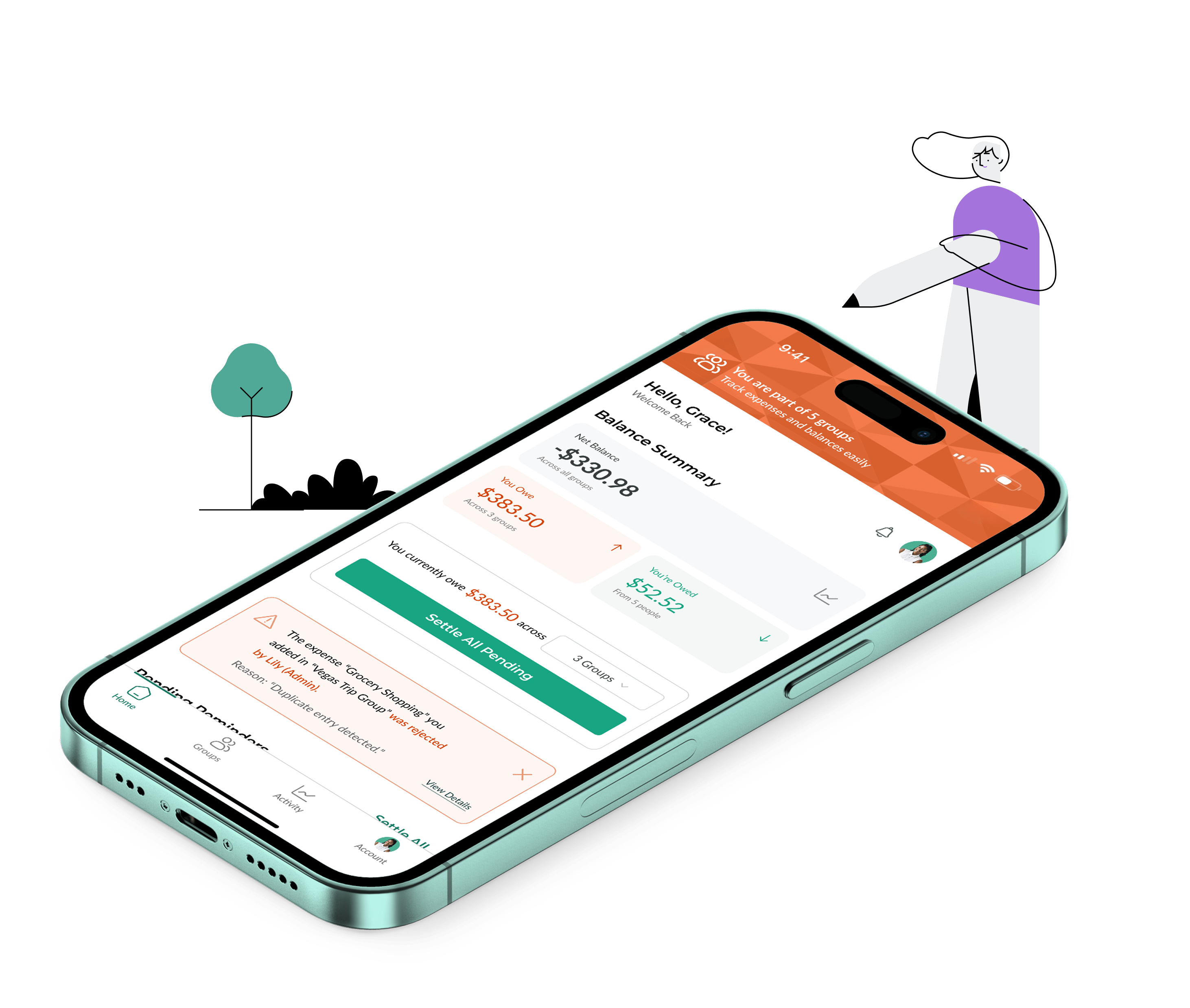
But first, lets explore the app through a critical lens.
Through our heuristic evaluation, we found that “Error Prevention” and “Visibility of System Status” were the most critical principals influencing Splitwise’s user experience.
We conducted a heuristic evaluation of Splitwise using Nielsen’s 10 usability heuristics to uncover friction points in managing large group expenses. While the app succeeds in promoting fairness and simplicity, our evaluation revealed key areas where users lose clarity, particularly in tracking payments, understanding balances, and managing reminders.
Heuristic Evaluation Results
How users feel about Splitwise
Splitwise’s tools fall short for real-life group dynamics.
Across forums and app stores, users didn’t hold back about their experiences. Many appreciated how Splitwise makes sharing expenses easier, but others shared where things start to break down: confusing settlements, hidden debts, and the emotional tension of constantly wondering “who owes whom.”
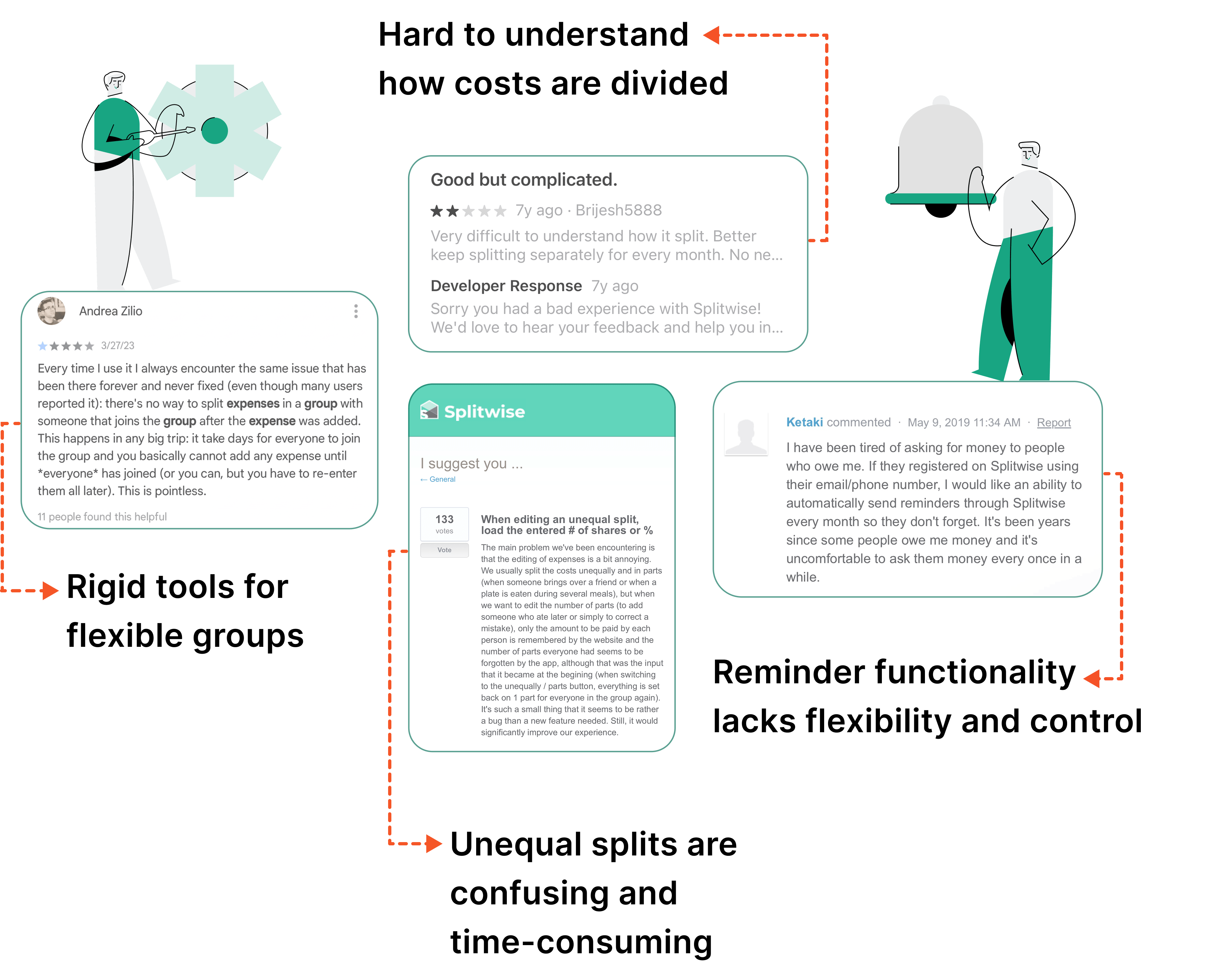
Seeing how competitors handle the same challenge
Research highlights the need for clear roles, transparency, and smart automation in Splitwise.
We evaluated Venmo, Tricount, Splid, and Settle Up to understand how they manage group expenses. Our focus was on clarity, trust-building, multi-currency management, and ease of use to identify opportunities for improving Splitwise’s overall experience.


Listening to users to uncover what really matters
Interviews and usability tests revealed trust gaps and emotional friction in group expenses.
We conducted 7 interviews with experienced Splitwise users who managed large groups and 5 usability tests with new users unfamiliar with the app. Our goal was to understand how experienced users handle complex group expenses and how first-time users navigate essential tasks.
These conversations uncovered recurring pain points: confusion around currencies, uncertainty about editable expenses, and hesitation to speak up about mistakes for fear of tension within the group.

Ultimately, user feedback revealed friction between fairness, transparency, and friendship, showing that managing money isn’t just about numbers, it’s about maintaining trust.
Turning conversations into actionable insights
Users need flexibility, clarity, and trust to manage shared expenses confidently.
Users value transparency and fairness in shared expenses but seek more comfort and clarity in the process. Managing money with friends is about trust and reducing tension, they want a system that feels fair, friendly, and effortless.
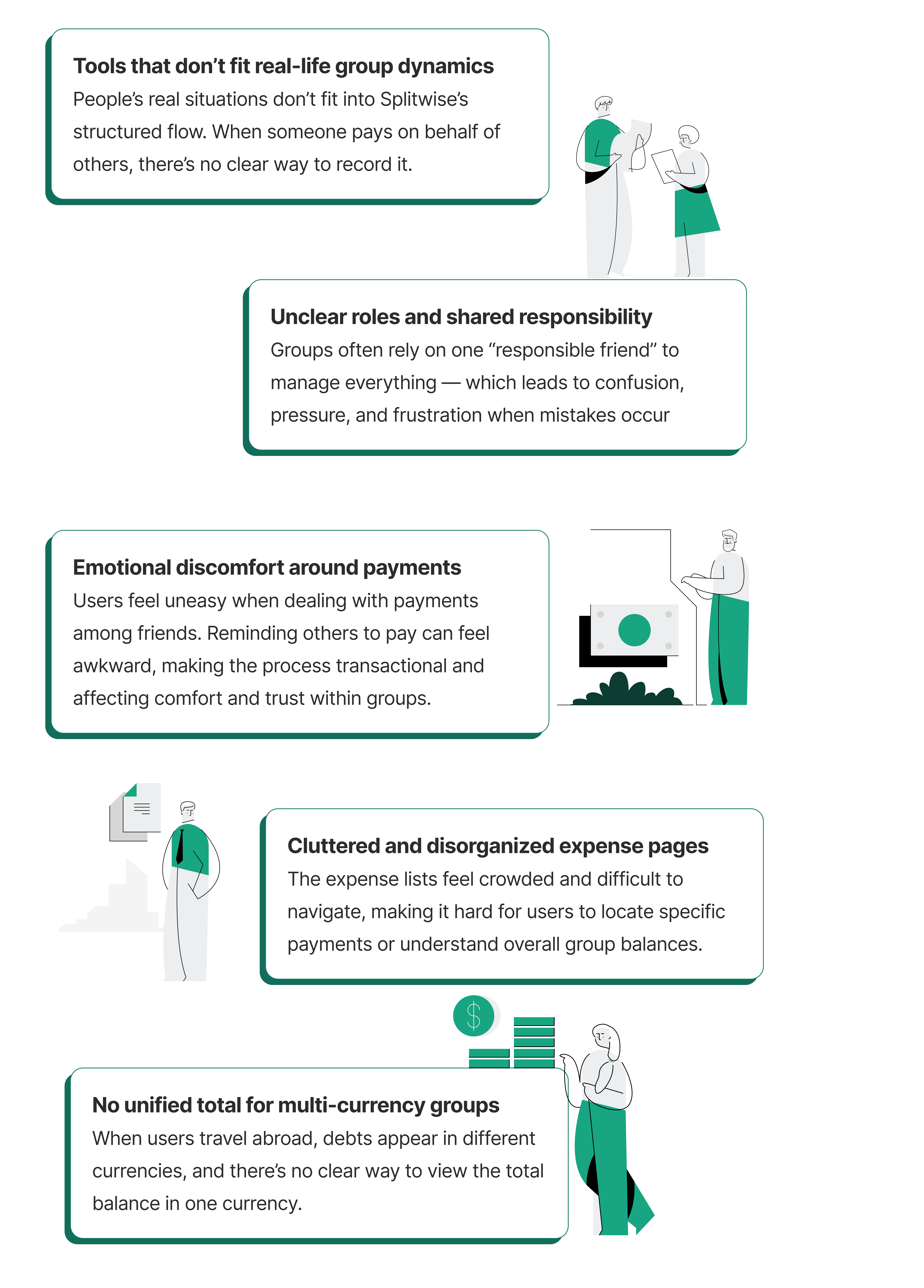
Walking in users’ shoes
Two contrasting mindsets reveal how emotions shape financial collaboration.
Our research revealed two key personas: Lily, the “Financial Guardian,” who values accuracy and fairness, and Daniel, the “Hesitant Participant,” who seeks clarity and reassurance.

Understanding how our users navigate Splitwise journeys
From confident to confused: Users lose trust during balance checks and error fixes.
Both Lily and Daniel begin their journeys feeling organized and optimistic, but frustration grows as they reach balance reviews and settlement steps. Missing confirmations, unclear totals, and lack of communication channels create emotional drop-offs, revealing clear opportunities for smoother guidance and reassurance.
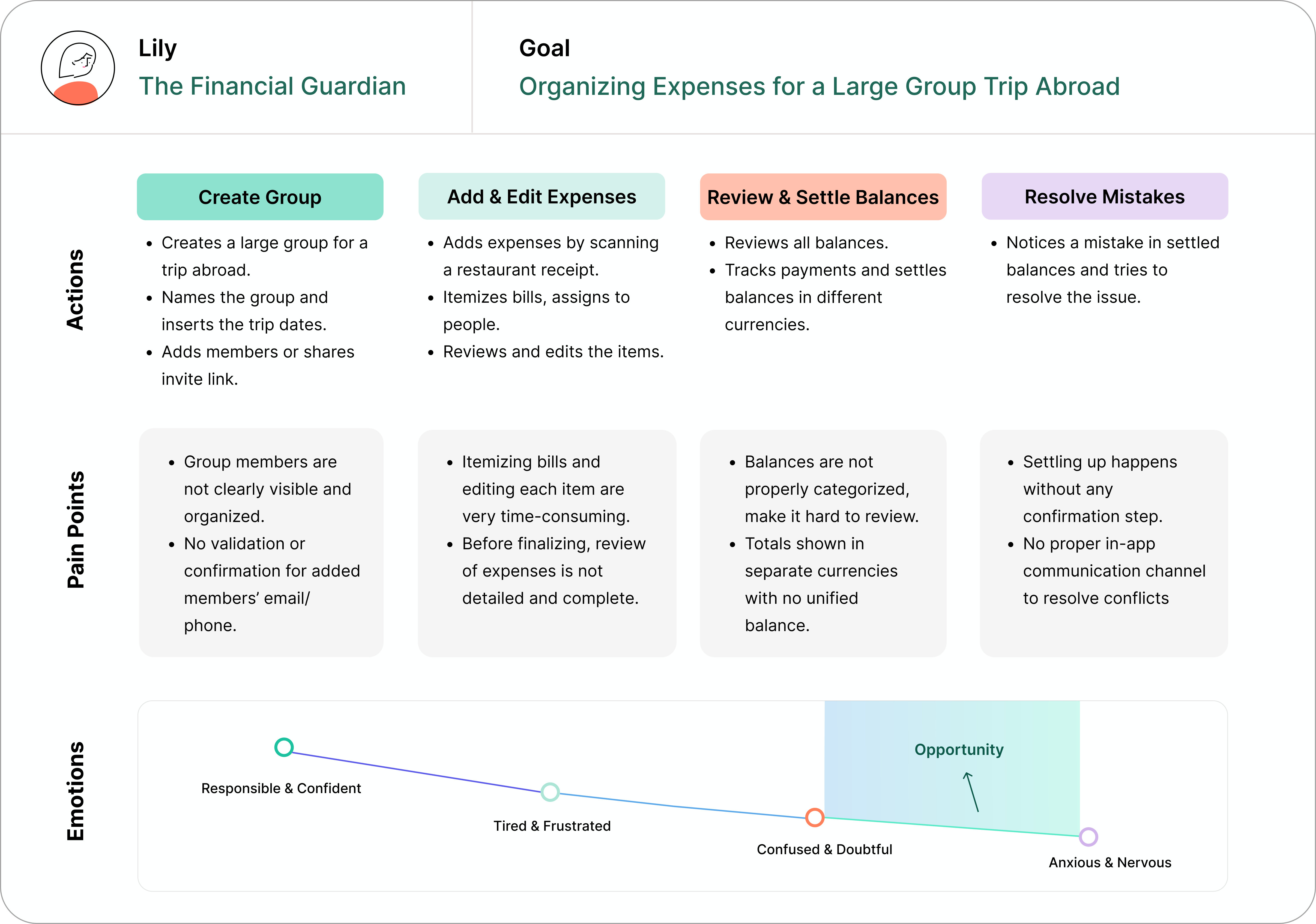

Turning user insights into actionable ideas
Key ideas centered on smarter automation, clearer roles, and transparent expense control.
We used an Effort–Impact Matrix to evaluate and prioritize ideas that balanced value and feasibility. This process helped us identify key opportunities such as multi-currency support, an expense breakdown view, a proxy payer mode, auto-reminders, duplicate expense detection, and a group admin role.
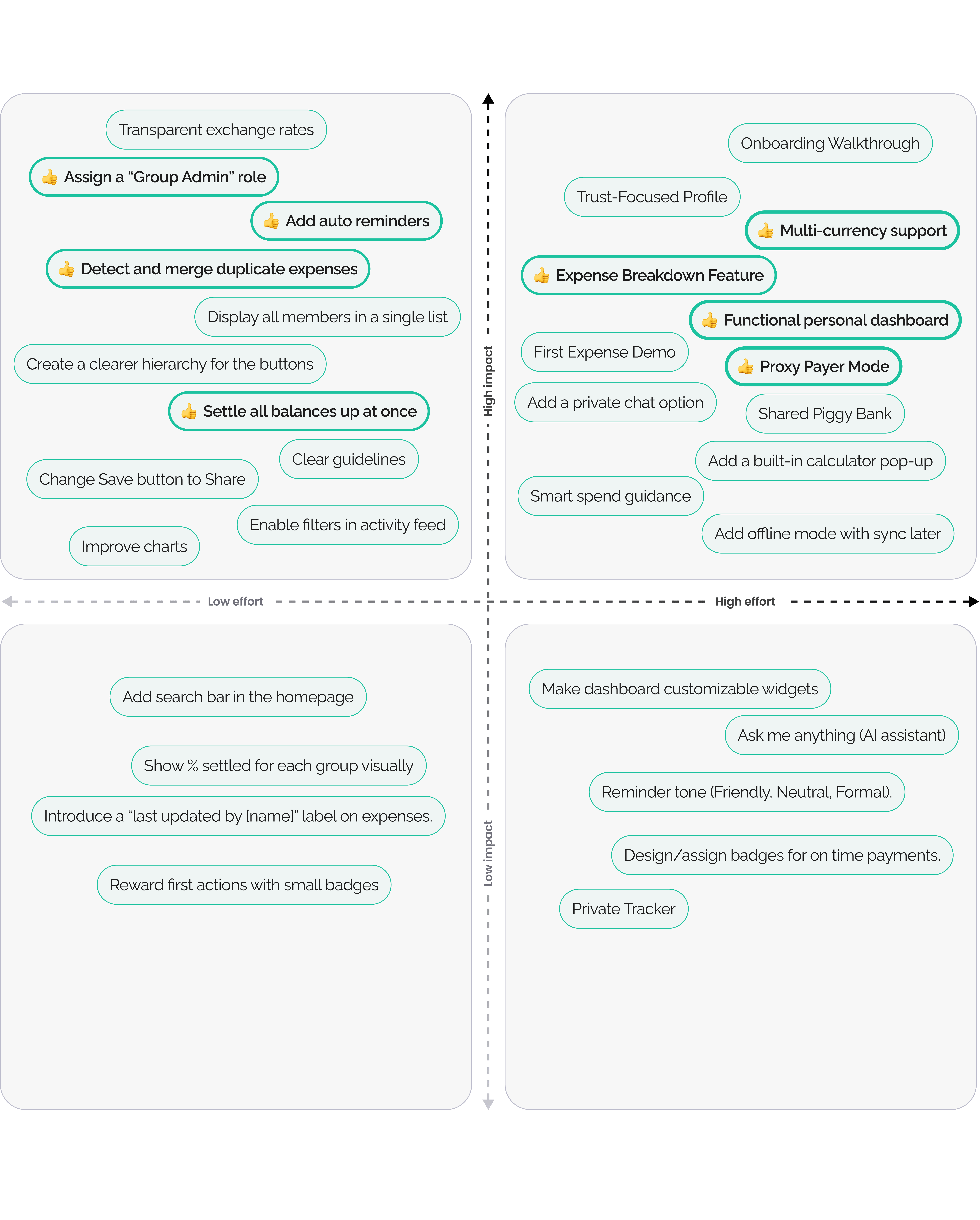
In addition to those high-impact, low-effort ideas, we also selected a few high-impact but high-effort concepts (such as the proxy payer mode and multi-currency support) to challenge our design thinking and push the experience further.
Bringing ideas to life
Turning complex group expenses into a clearer, smarter, and more effortless experience.
We brought our ideas to life with features like a personal dashboard, group admin controls, smart auto-reminders, and proxy payer mode.
With real-time currency sync, expense breakdown pop-ups, and duplicate detection, the redesign made Splitwise clearer, faster, and more reliable.
Personal Dashboard


Group Admin Control

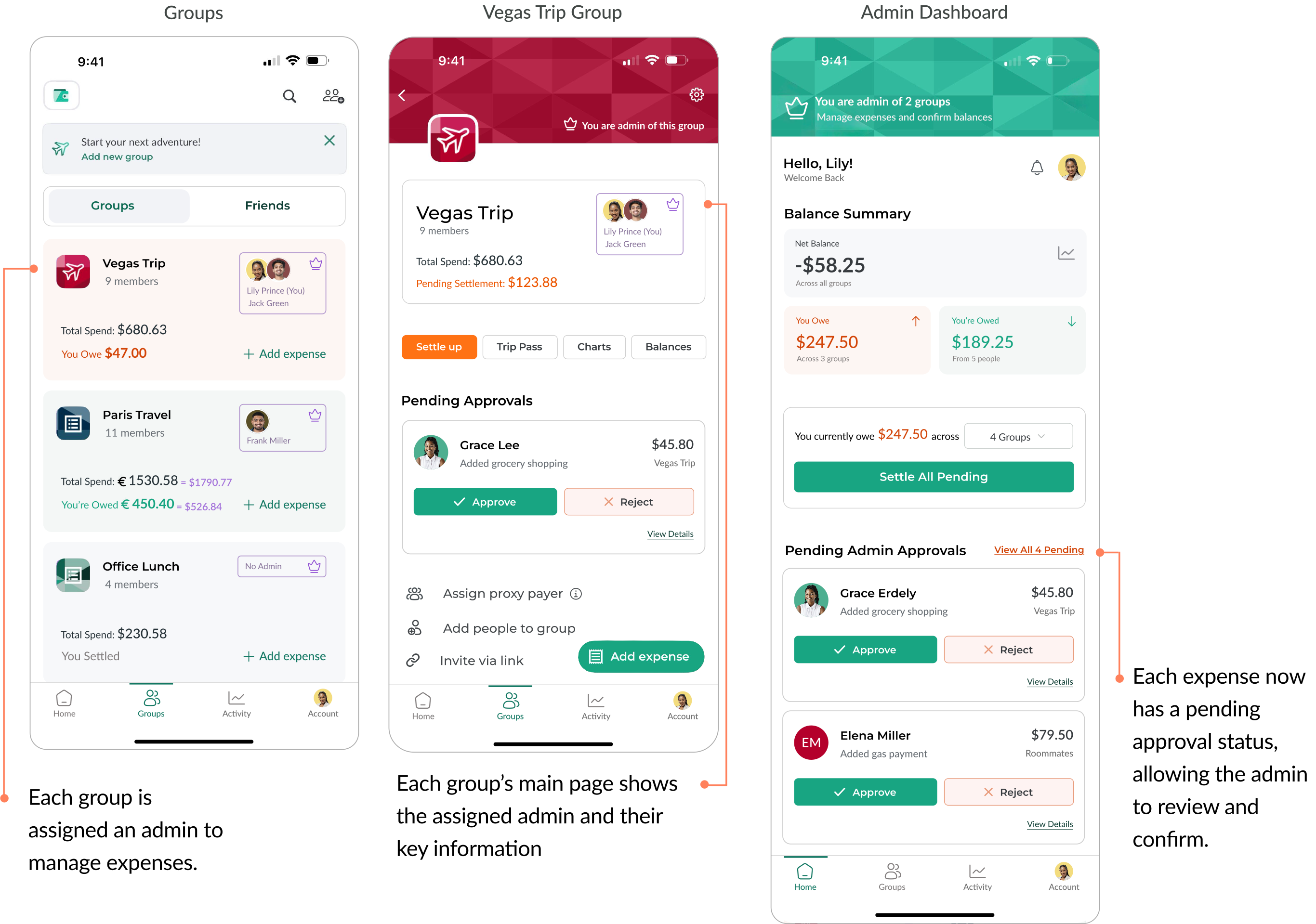
Smart Auto Reminder
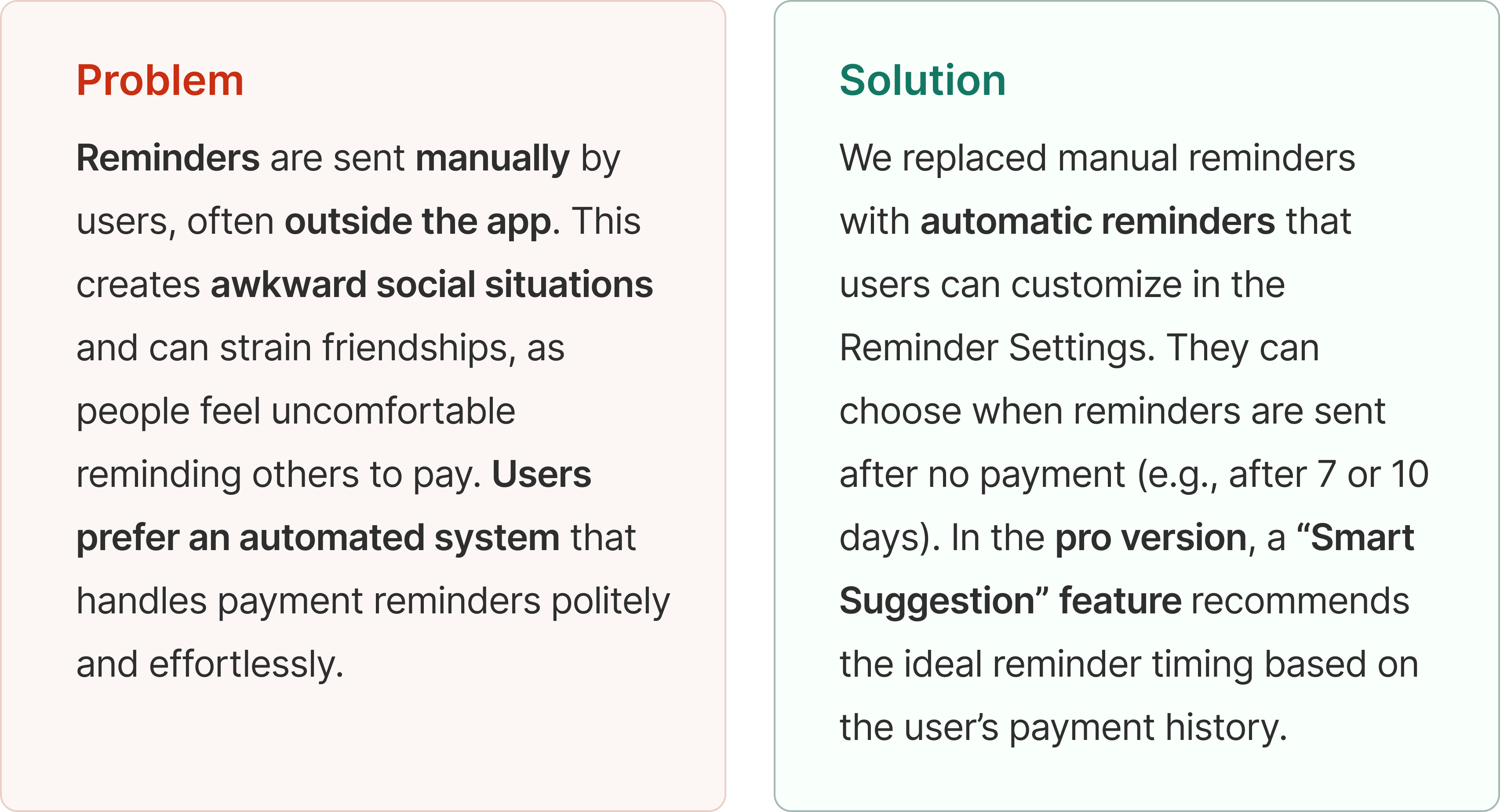
Before
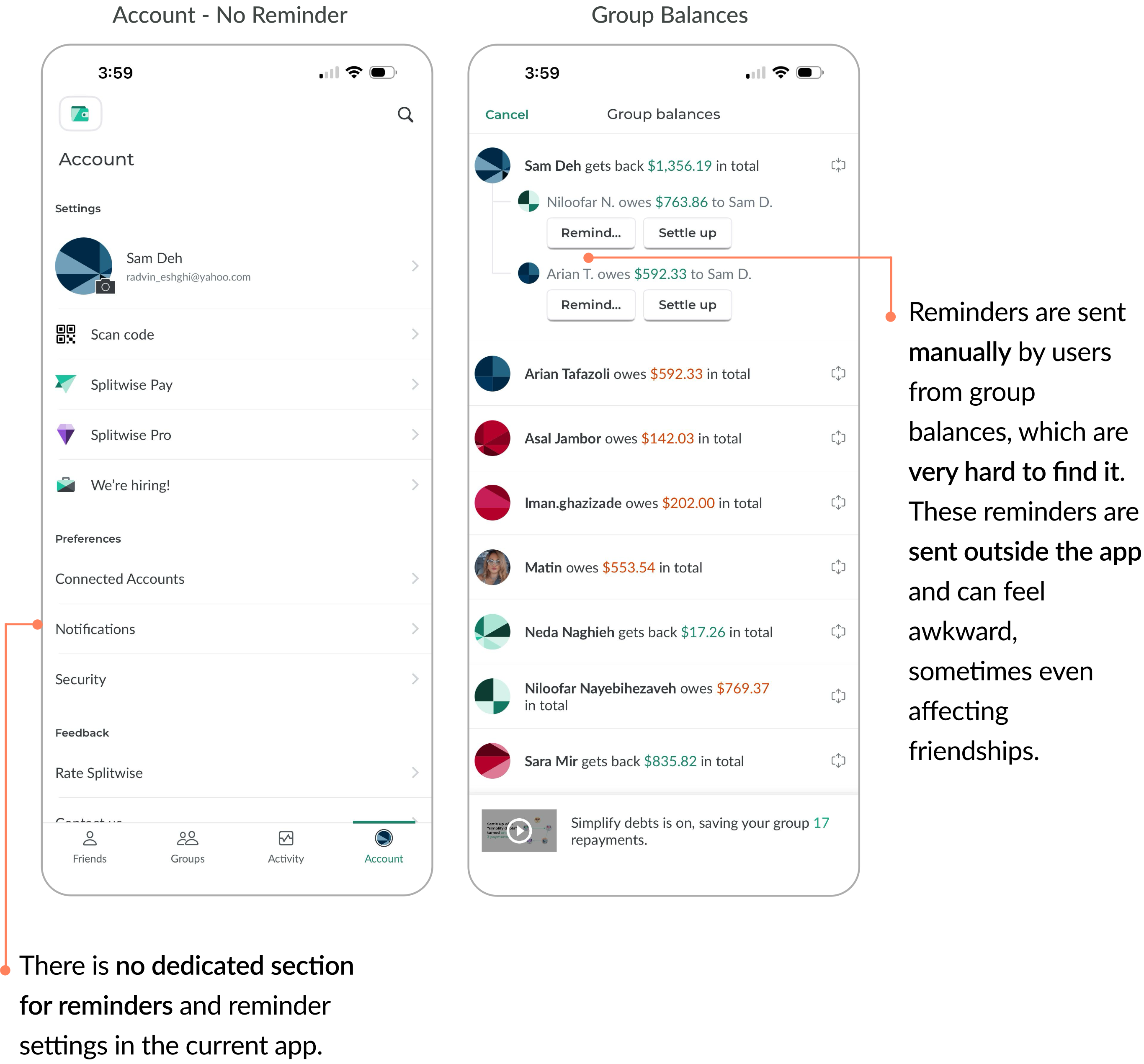
After
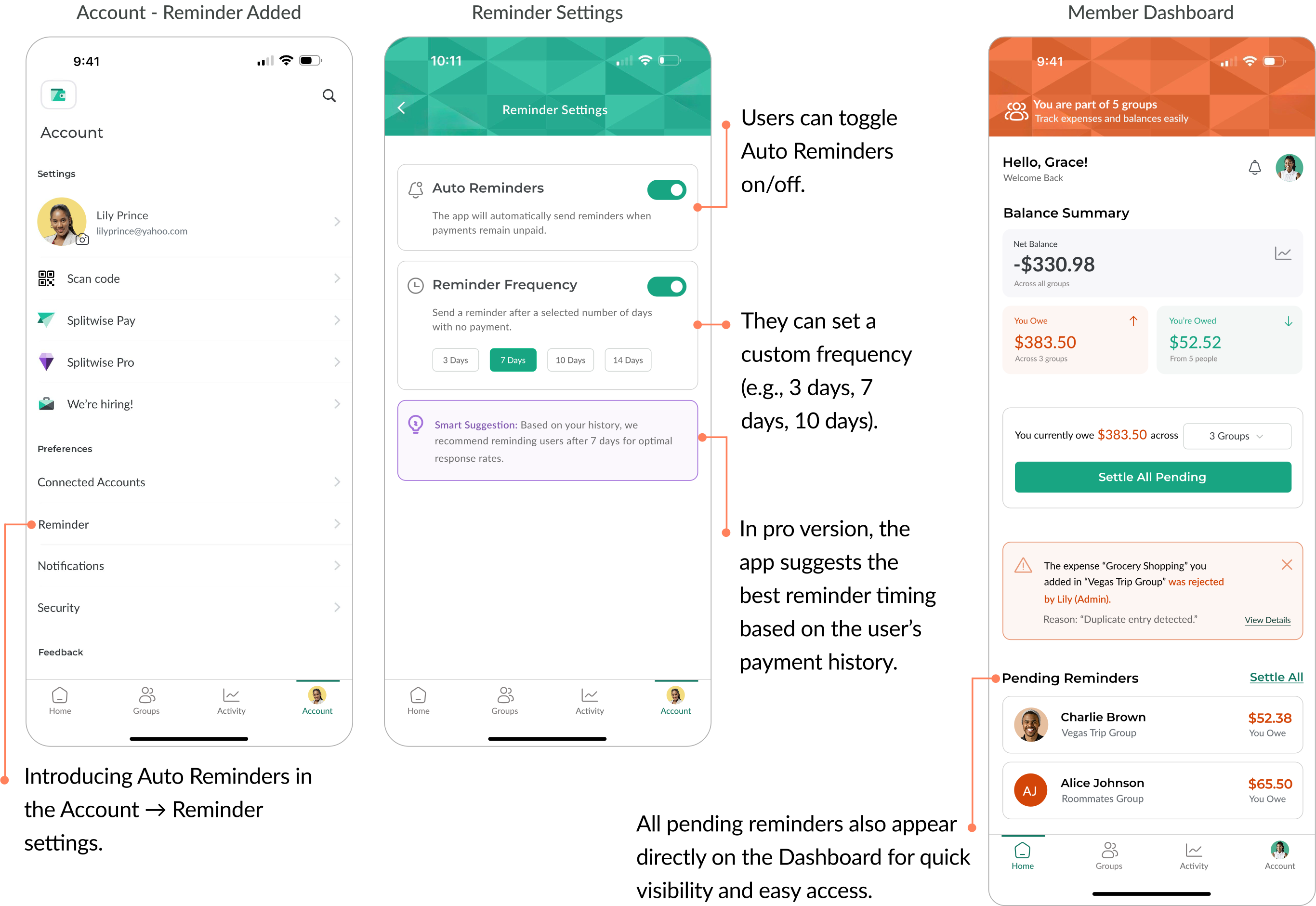
Proxy Payer Feature
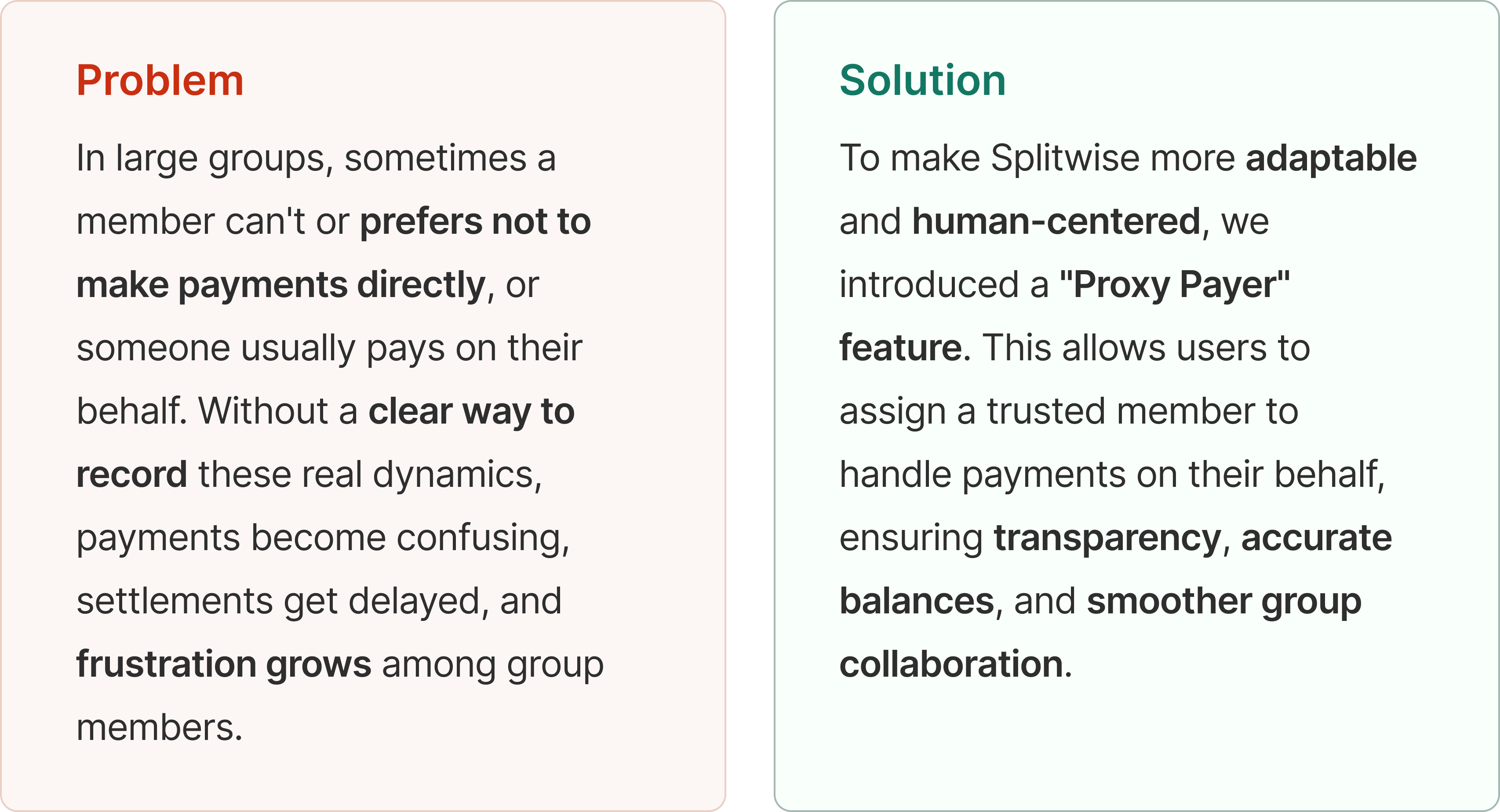
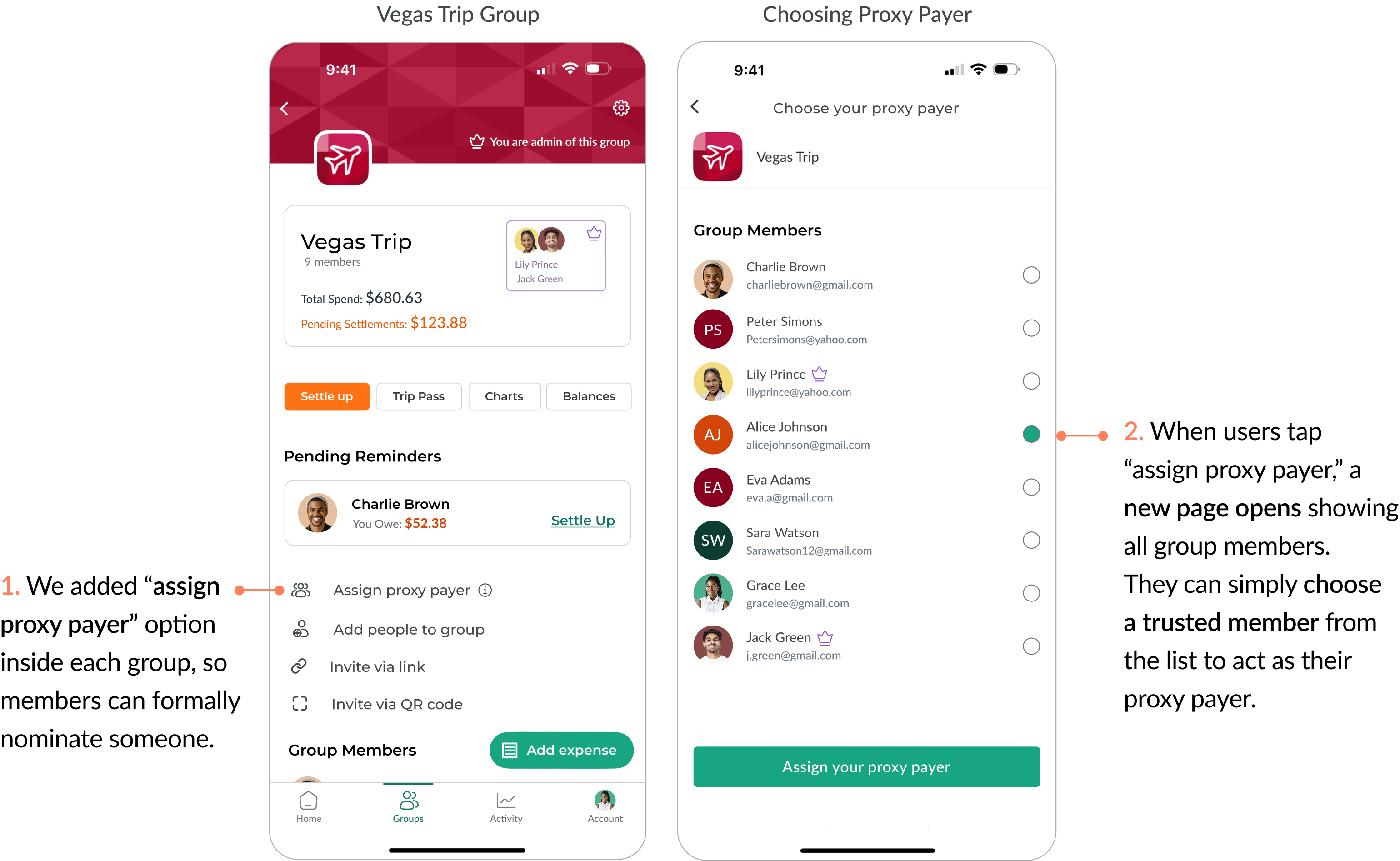


Real-Time Multi-Currency Sync


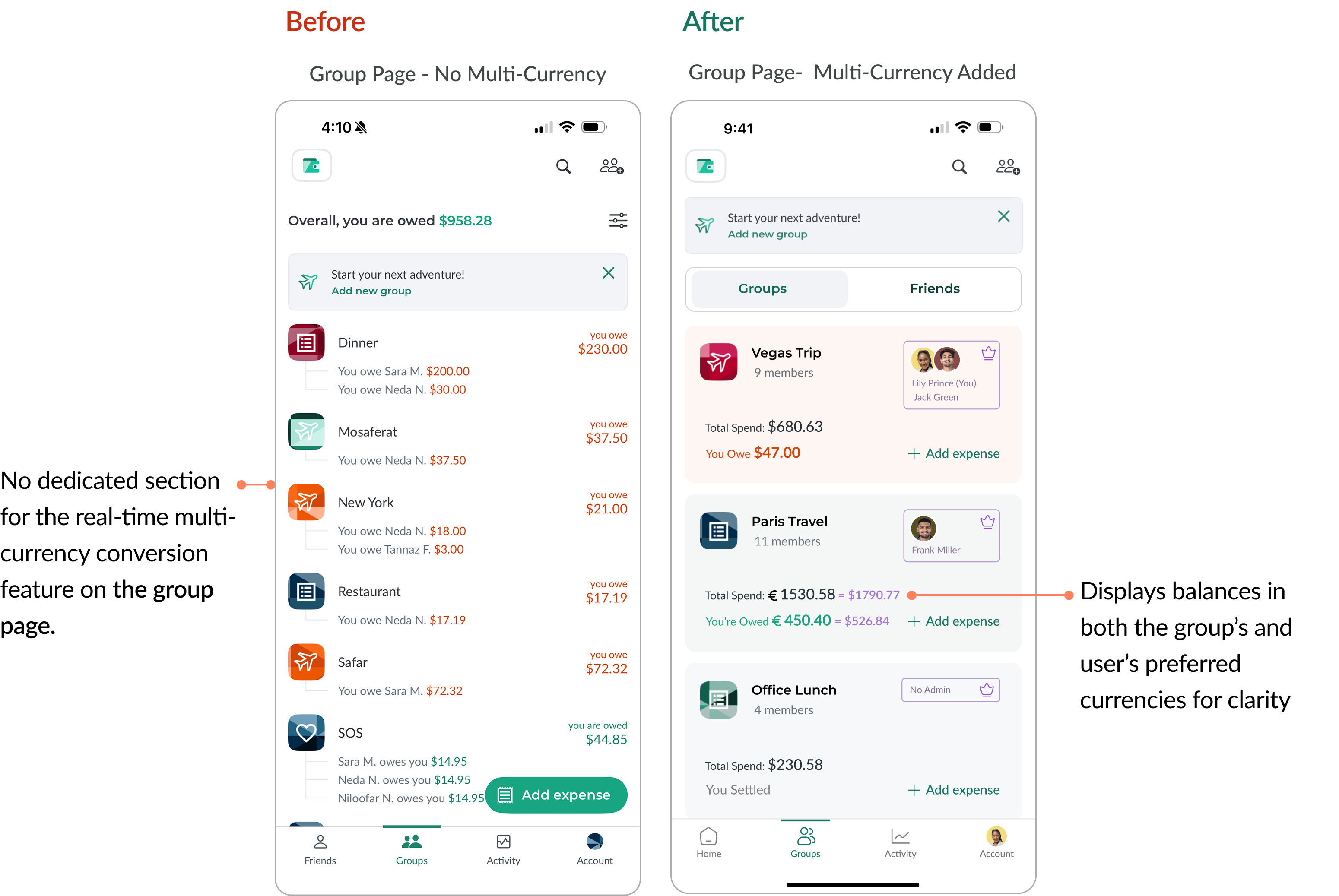
Expense Breakdown Pop-Up
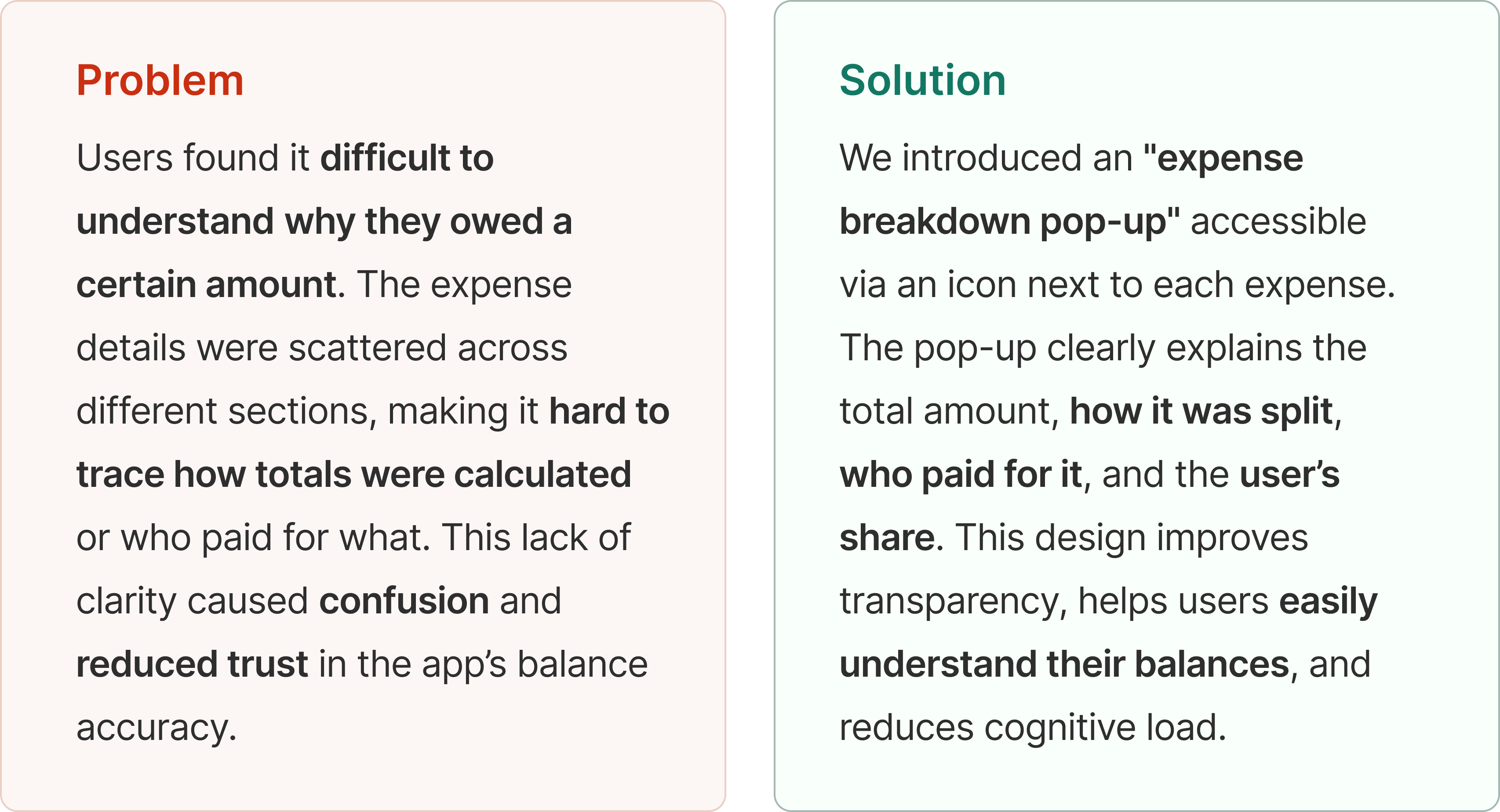

Duplicate Expense Detection
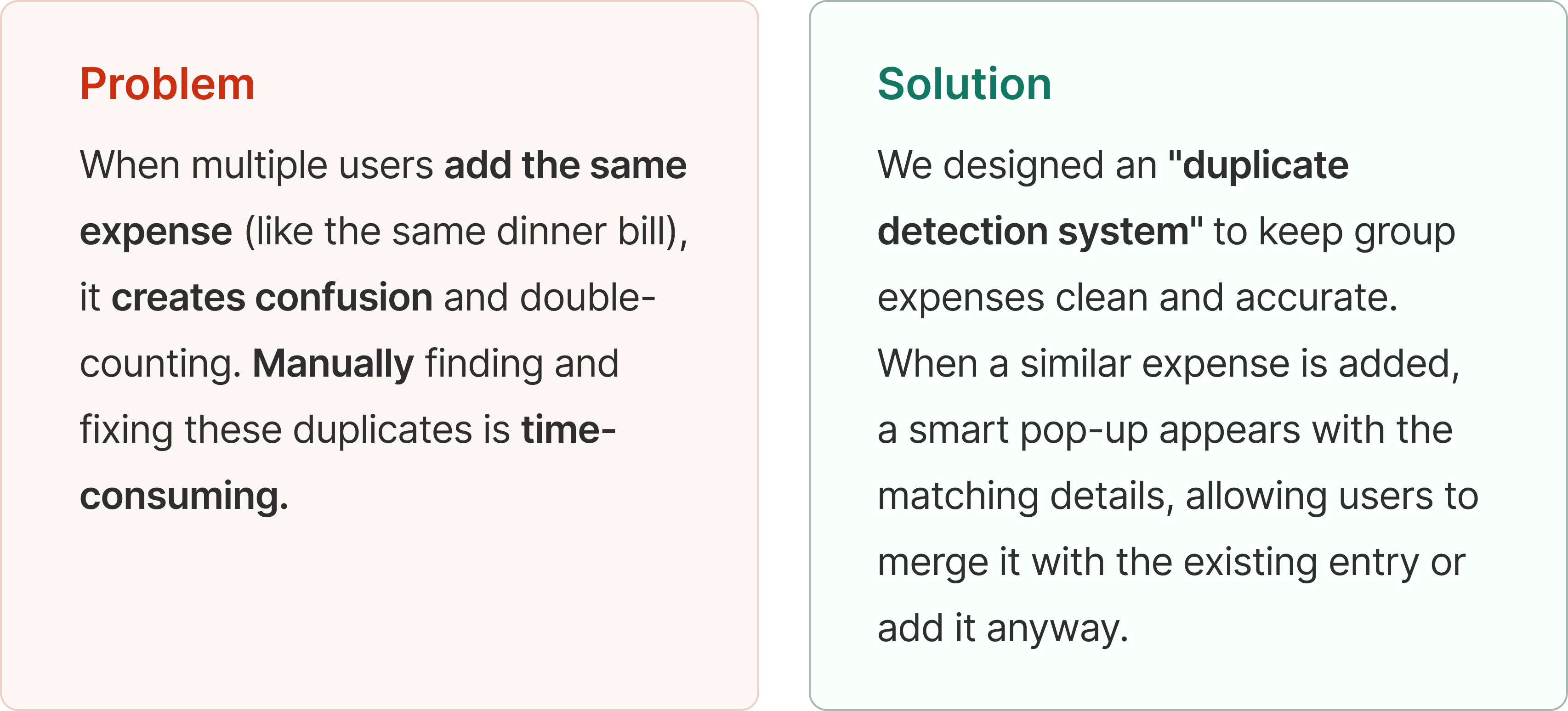
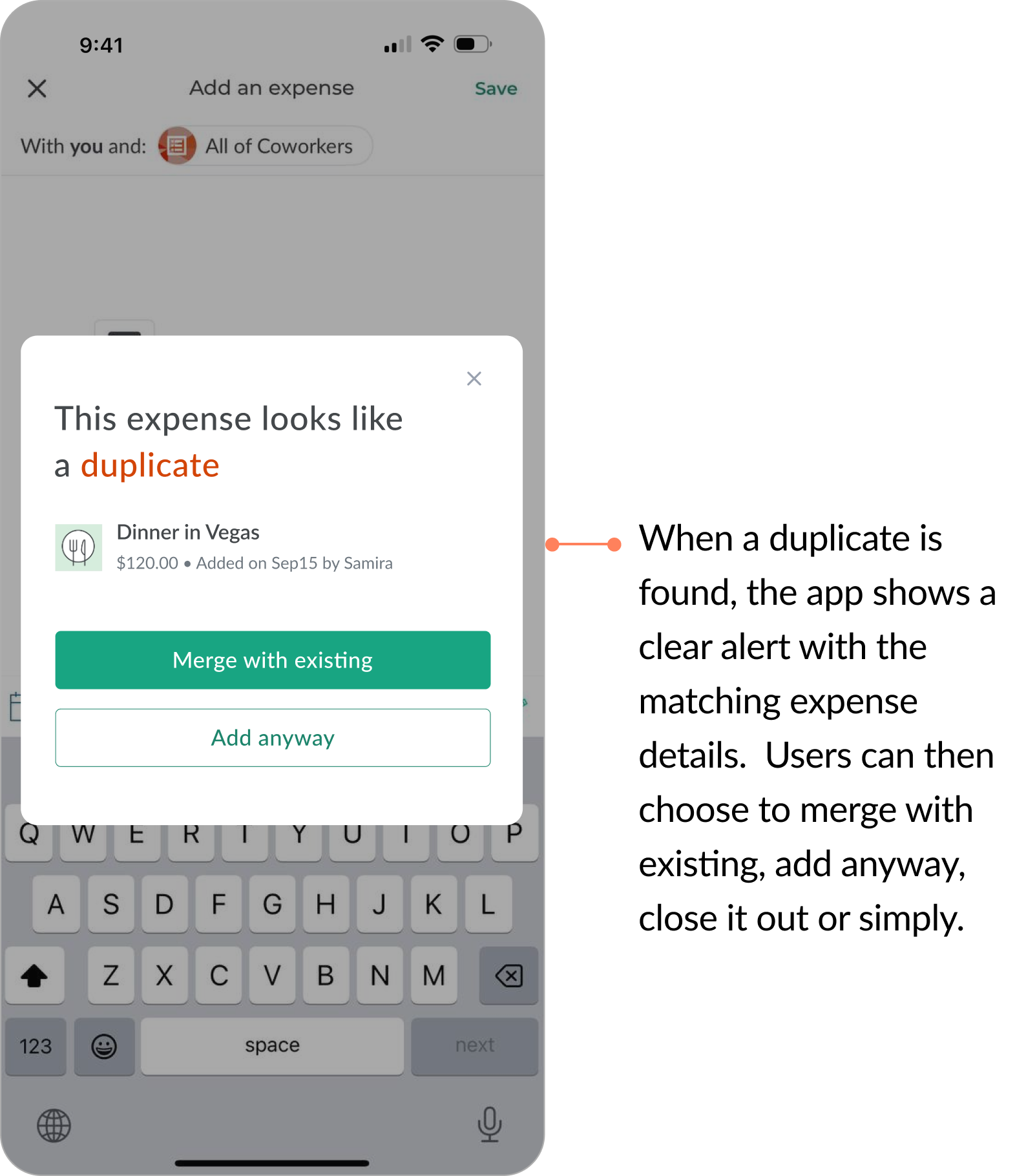
Impacts From User Feedbacks
User feedback highlights the power of clarity and role definition in building financial trust.
Since we didn’t have real usage data, we focused on what users said and how they felt during testing. Our users’ feedback showed us exactly what mattered most: giving them a clearer sense of who can do what, and making the process of managing group expenses more transparent and stress-free.
If this redesign were implemented, we would measure success by how confidently users handle shared expenses and how smoothly they adopt these new tools.
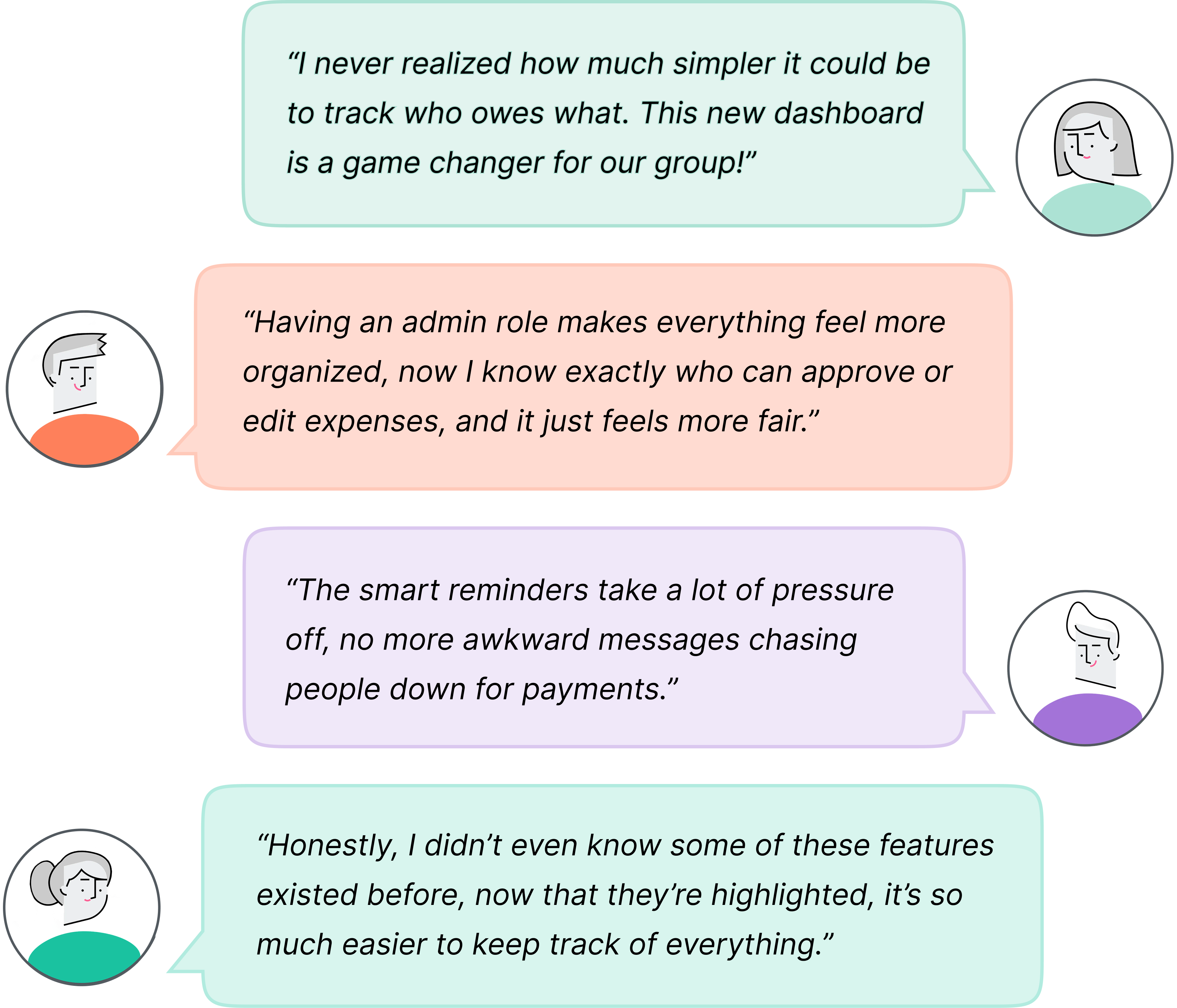
What we learned
Learning from challenges and collaboration
Balancing Emotion and Strategy
Designing for users means understanding both their feelings and their goals. I learned how trust, fairness, and small emotional cues can shape financial behaviors as much as functionality does. Every decision should speak to both the heart and the logic of the user.
Turning Collaboration into Clarity
Working closely with my teammate taught me the value of open discussion and feedback loops. When ideas are challenged and refined together, even the most complex problems can transform into clear, human-centered solutions.
Designing Beyond Usability
True design impact goes beyond fixing usability issues. I learned that every interaction is an opportunity to build empathy, preserve relationships, and make people feel understood, pixel by pixel.
Next steps
Moving from concept to validation
The next phase will focus on usability testing and collecting real user feedback to validate our assumptions. Future iterations could explore advanced features such as AI-powered spending insights, improved multi-currency support, and integration with payment platforms to streamline settlements.
These steps will help transform this concept project into a more realistic, scalable solution ready for real-world users.

Empowering Splitwise Users with Smarter Expense Management
Introduced admin roles, proxy payers, auto reminder, and multi-currency support to make expense management effortless and transparent.

Introduction
Splitwise, a diamond built on trust!
Splitwise is a popular app for easily splitting expenses among friends and groups. At its core, it values friendship and fairness, making sure no one feels awkward about money, even its diamond-shaped design subtly reminds users that true friendships, like diamonds, are precious and worth keeping clear.
Can Splitwise really preserve the friendships it promises to protect? Let’s find out.


What is the problem?
Splitwise users face challenges in managing large groups, such as tracking individual contributions, splitting specific bills, or resolving disputes, impacting its usability for shared expenses.
As groups get larger, keeping track of who paid, what’s still pending, and managing disputes can get confusing. This project aims to simplify expense management and increase trust and transparency.

What are we aiming to achieve in our design?
To simplify group expense management by improving Splitwise’s flexibility and clarity, ensuring users can track, split, and settle expenses effortlessly, with less confusion and more confidence.
This project’s design goal is to make Splitwise a tool that supports both fairness and friendship through clarity.

But first, lets explore the app through a critical lens.
Through our heuristic evaluation, we found that “Error Prevention” and “Visibility of System Status” were the most critical principals influencing Splitwise’s user experience.
We conducted a heuristic evaluation of Splitwise using Nielsen’s 10 usability heuristics to uncover friction points in managing large group expenses. While the app succeeds in promoting fairness and simplicity, our evaluation revealed key areas where users lose clarity, particularly in tracking payments, understanding balances, and managing reminders.

Heuristic Evaluation Results
How users feel about Splitwise
Splitwise’s tools fall short for real-life group dynamics.
Across forums and app stores, users didn’t hold back about their experiences. Many appreciated how Splitwise makes sharing expenses easier, but others shared where things start to break down: confusing settlements, hidden debts, and the emotional tension of constantly wondering “who owes whom.”

Seeing how competitors handle the same challenge
Research highlights the need for clear roles, transparency, and smart automation in Splitwise.
We evaluated Venmo, Tricount, Splid, and Settle Up to understand how they manage group expenses. Our focus was on clarity, trust-building, multi-currency management, and ease of use to identify opportunities for improving Splitwise’s overall experience.


Listening to users to uncover what really matters
Interviews and usability tests revealed trust gaps and emotional friction in group expenses.
We conducted 7 interviews with experienced Splitwise users who managed large groups and 5 usability tests with new users unfamiliar with the app. Our goal was to understand how experienced users handle complex group expenses and how first-time users navigate essential tasks.
These conversations uncovered recurring pain points: confusion around currencies, uncertainty about editable expenses, and hesitation to speak up about mistakes for fear of tension within the group.

Ultimately, user feedback revealed friction between fairness, transparency, and friendship, showing that managing money isn’t just about numbers, it’s about maintaining trust.
Turning conversations into actionable insights
Users need flexibility, clarity, and trust to manage shared expenses confidently.
Users value transparency and fairness in shared expenses but seek more comfort and clarity in the process. Managing money with friends is about trust and reducing tension, they want a system that feels fair, friendly, and effortless.

Walking in users’ shoes
Two contrasting mindsets reveal how emotions shape financial collaboration.
Our research revealed two key personas: Lily, the “Financial Guardian,” who values accuracy and fairness, and Daniel, the “Hesitant Participant,” who seeks clarity and reassurance.
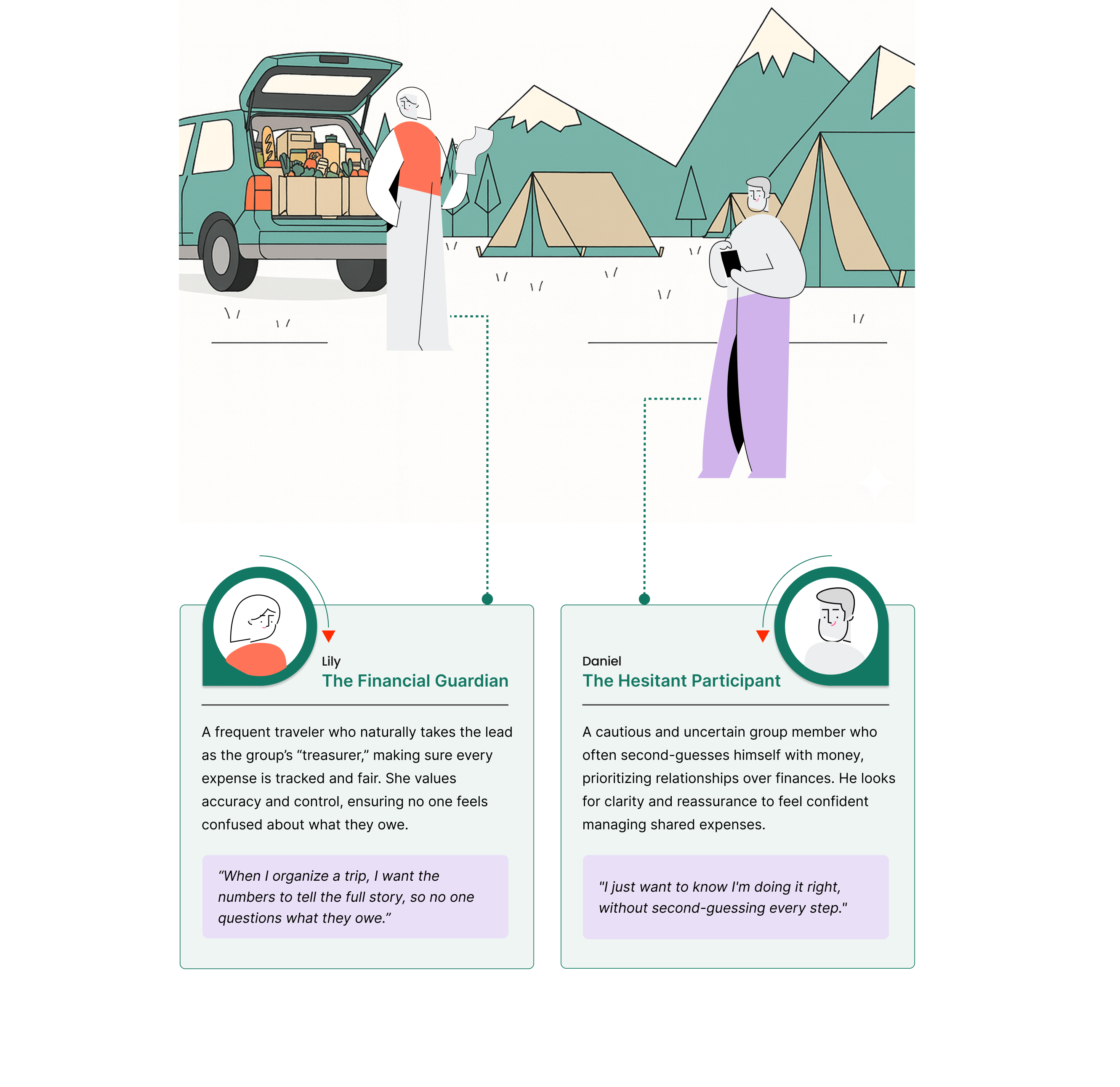
Understanding how our users navigate Splitwise journeys
From confident to confused: Users lose trust during balance checks and error fixes.
Both Lily and Daniel begin their journeys feeling organized and optimistic, but frustration grows as they reach balance reviews and settlement steps. Missing confirmations, unclear totals, and lack of communication channels create emotional drop-offs, revealing clear opportunities for smoother guidance and reassurance.


Turning user insights into actionable ideas
Key ideas centered on smarter automation, clearer roles, and transparent expense control.
We used an Effort–Impact Matrix to evaluate and prioritize ideas that balanced value and feasibility. This process helped us identify key opportunities such as multi-currency support, an expense breakdown view, a proxy payer mode, auto-reminders, duplicate expense detection, and a group admin role.

In addition to those high-impact, low-effort ideas, we also selected a few high-impact but high-effort concepts (such as the proxy payer mode and multi-currency support) to challenge our design thinking and push the experience further.
Bringing ideas to life
Turning complex group expenses into a clearer, smarter, and more effortless experience.
We brought our ideas to life with features like a personal dashboard, group admin controls, smart auto-reminders, and proxy payer mode.
With real-time currency sync, expense breakdown pop-ups, and duplicate detection, the redesign made Splitwise clearer, faster, and more reliable.
Personal Dashboard


Group Admin Control


Smart Auto Reminder

Before

After

Proxy Payer Feature




Real-Time Multi-Currency Sync



Expense Breakdown Pop-Up

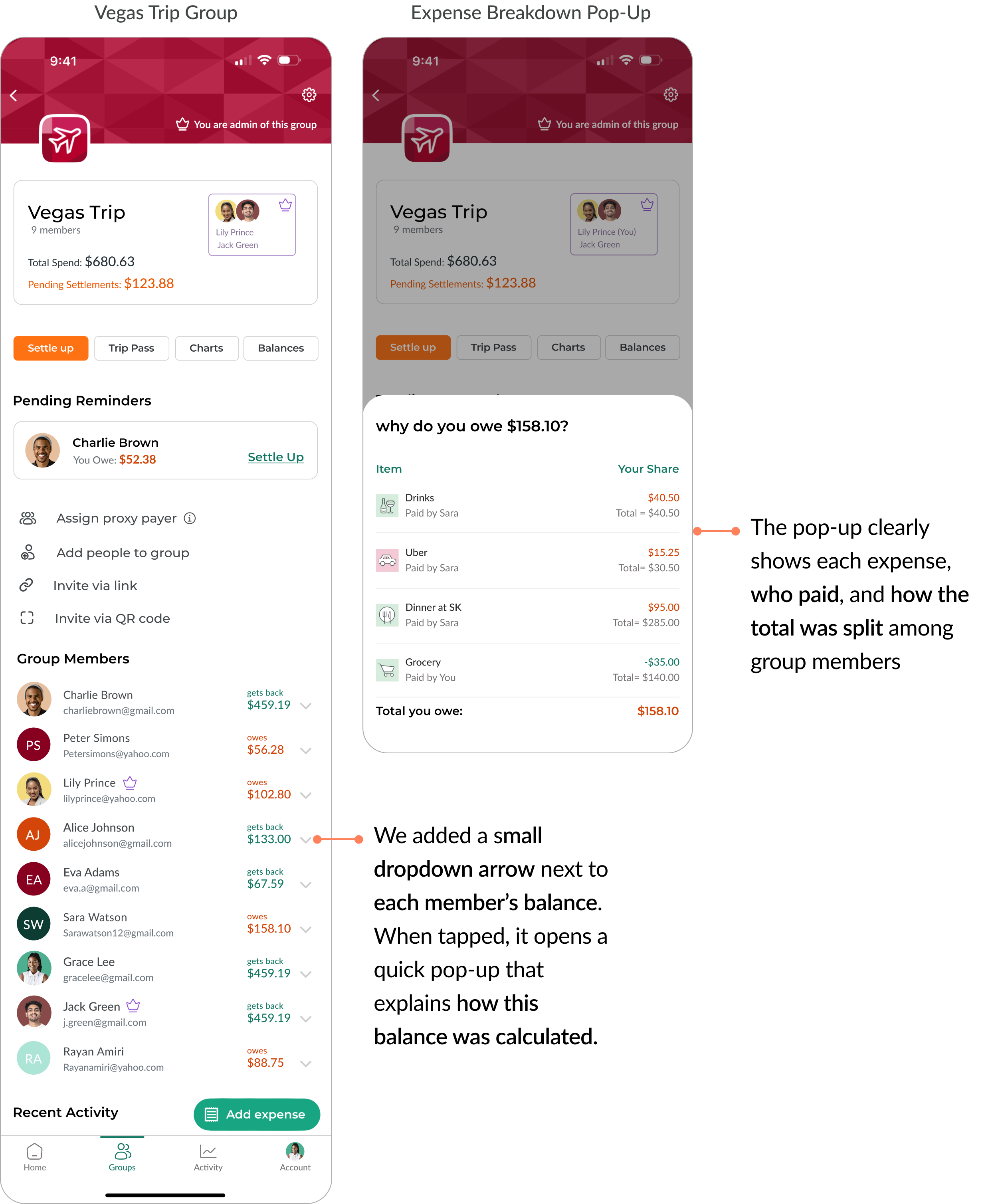
Duplicate Expense Detection


Impacts From User Feedbacks
User Feedback Highlights the Power of Clarity and Role Definition in Building Financial Trust.
Since we didn’t have real usage data, we focused on what users said and how they felt during testing. Our users’ feedback showed us exactly what mattered most: giving them a clearer sense of who can do what, and making the process of managing group expenses more transparent and stress-free.
If this redesign were implemented, we would measure success by how confidently users handle shared expenses and how smoothly they adopt these new tools.

What we learned
Learning from challenges and collaboration
Balancing Emotion and Strategy
Designing for users means understanding both their feelings and their goals. I learned how trust, fairness, and small emotional cues can shape financial behaviors as much as functionality does. Every decision should speak to both the heart and the logic of the user.
Turning Collaboration into Clarity
Working closely with my teammate taught me the value of open discussion and feedback loops. When ideas are challenged and refined together, even the most complex problems can transform into clear, human-centered solutions.
Designing Beyond Usability
True design impact goes beyond fixing usability issues. I learned that every interaction is an opportunity to build empathy, preserve relationships, and make people feel understood, pixel by pixel.
Next steps
Moving from concept to validation
The next phase will focus on usability testing and collecting real user feedback to validate our assumptions. Future iterations could explore advanced features such as AI-powered spending insights, improved multi-currency support, and integration with payment platforms to streamline settlements.
These steps will help transform this concept project into a more realistic, scalable solution ready for real-world users.

